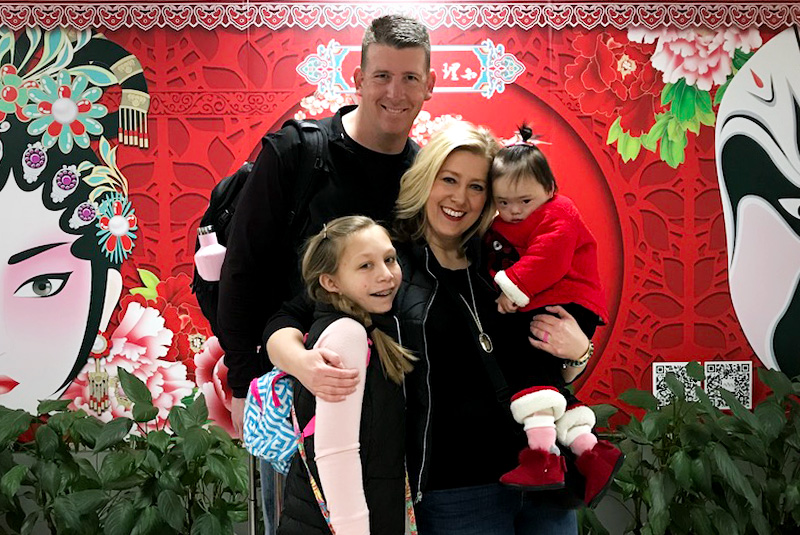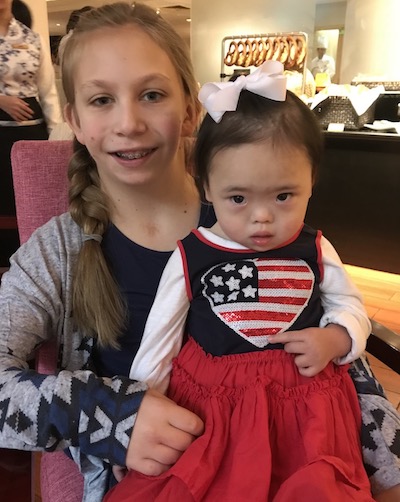Everli: Living her best life after atlantoaxial instability

When they travelled to the orphanage in China in early 2018, Shannon and Matt Gottschalk knew the toddler they hoped to adopt had Down syndrome. They knew she had been abandoned by the side of a highway and delivered to an orphanage by the farmer who’d found her. The couple was surprised, however, that at 2½ years old, the child could barely stand on her own. At the time, they had never heard of atlantoaxial instability.
By then, Shannon, Matt, and their daughter Maddi had already fallen in love with the tiny girl they had seen in photos. They named her Everli and vowed to give her the best life they possibly could. The problems with her cervical spine didn’t become apparent until two months after they brought her home to Oklahoma.
Atlantoaxial instability in children with Down syndrome

About 10 to 20 percent of kids with Down syndrome have excess mobility between the vertebrae at the top of their spine, a condition known as atlantoaxial instability (AAI). In most children, the condition never becomes symptomatic. But in about 1 to 2 percent of children with Down syndrome, the vertebrae compress the spinal cord, interfering with signals between the brain and the rest of the body. Everli was part of this small group.
Her symptoms appeared one morning in early April. At breakfast, her head tilted over and she would barely move. “I thought maybe she’d had a stroke,” says Matt. Despite numerous doctors’ visits and medical tests, the right side of Everli’s body was almost fully paralyzed by the end of that week. Finally, while looking for signs of a brain tumor, a radiologist saw that the vertebrae at the top of her spine were pinching her spinal cord.
Failed surgery and a second opinion
Everli underwent traction and spinal fusion surgery in Oklahoma. Five-and-a-half months later, her spine remained unstable. The Gottschalks consulted a surgeon in Dallas who told them the vertebrae were not properly aligned. The couple had been looking forward to the day their daughter wouldn’t have to wear the halo vest that held her head immobile while her spine healed. But the surgeon in Dallas warned them that Everli’s neck remained unstable and advised them to seek further treatment. The couple drove home from Texas in shock, wondering what to do next.
One more chance to get it right
On October 30, 2018, Shannon sent an email to orthopedic surgeon, Dr. Daniel Hedequist. “I sent the email at 10 p.m.,” she says. “By the next morning, he had already responded.” Shannon arranged to have images of Everli’s spine sent to Boston. On the afternoon of Halloween, she and Matt were on the phone with Dr. Hedequist, who had already consulted with neurosurgeon Dr. Mark Proctor. Together, the two surgeons, co-directors of the Complex Cervical Spine Program, represented the specific expertise Everli needed: neurosurgery and orthopedic surgery.
“It was clear from the images that the vertebrae were improperly aligned and the spinal cord was still compressed,” recalls Dr. Hedequist. “Without revision surgery, Everli was at severe risk of full paralysis and possibly even death.” To reverse her steady decline, Dr. Proctor would first decompress Everli’s spinal cord. Then Dr. Hedequist would stabilize her cervical spine with a plate, screws, and rods. She would spend another three months in the halo vest, but once her spine healed, she could start building strength and mobility.

A medical flight to Boston
Shannon and Matt considered the revision surgery their final chance to save their daughter’s life. But the surgery had to be rescheduled twice when she developed pneumonia and became too weak to fly. The more time passed, the more her respiratory health declined. The Gottschalks started to ask themselves, “Did we fly halfway around the world to bring this child here just so she wouldn’t die alone?”
Finally, Everli’s clinical teams in Oklahoma and Boston arranged a flight on a medical jet. The family arrived in Boston on a cold Saturday in January 2019. The surgery to correct Everli’s atlantoaxial instability took place on Monday. A few weeks later, the Gottschalks returned home. “When we brought her back to the rehabilitation hospital in Oklahoma, the nurses and therapists who knew her were amazed,” says Shannon. The child who’d had to be repeatedly hospitalized that fall and winter was now visibly growing stronger and healthier.

Everli’s neck grows stronger
For the next three months, Dr. Hedequist consulted with Shannon and Matt by phone and email. When Everli’s neck had grown strong enough to support itself without the halo vest, her parents decided to return to Boston to have it removed.
Though they had looked forward to this occasion for months, Matt and Shannon couldn’t shake their anxiety. “We asked Dr. Hedequist question after question,” remembers Matt. Was he positive her spine was strong enough? What if she fell or ran into something? The surgeon’s answers reassured them, but his personal response put them at ease. “I’m a parent too,” Matt remembers him saying. “If this were my child, this is what I would do.”
Living her best life after atlantoaxial instability
For a while after the halo vest came off, Everli wore a less cumbersome brace, and then a soft cervical collar. Since July, she has not had to wear a brace or collar of any kind. “Without a shadow of a doubt, coming to Boston saved her life,” says Shannon. “Dr. Hedequist, Dr. Proctor, and the surgery they performed gave her the opportunity to live her best life.”
These days, Everli’s best life includes playing with Maddi and spending as much time outdoors as possible. Now 4 years old, she zips around the playground with the help a gait trainer. Each day, when recess ends, her preschool teachers have to coax her inside. Shannon and Matt are delighted to see their daughter’s personality emerge, a far cry from the sad, withdrawn child they met in the orphanage almost two years ago. In November, she was the flower girl at her physical therapist’s wedding.
The Gottschalk’s next goal for Everli is to teach her to walk without the gait trainer, though she has yet to embrace the idea. “We’ve learned that Everli does things on her own time,” laughs Shannon. She and Matt remind themselves that at her current level of mobility, Everli is more independent than she has ever been. “Given what her first two years were like, we’re very grateful she has such a strong personality. That stubbornness probably helped her survive.”

Learn more about the Complex Cervical Spine Program.
Related Posts :
-

Saif looks ahead to life after spine surgery
Saif and his mother, Khawha Abbas, both had questions for Dr. Daniel Hedequist. For the past nine months, the family ...
-

Gracie’s complex spine
Halloween 2018 was no ordinary ghouls’ day for Gracie Neef. She and both her parents dressed up as the witches from “...
-

Spinal fusion surgery during COVID-19
If things had gone according to plan, Jared Cohen would have had spinal fusion surgery during his April vacation. His ...
-

Scoliosis patients get a preview of spinal fusion surgery
“Patients are more at ease when they know what to expect,” says, Dr. Daniel Hedequist, chief of the Spine Division ...





